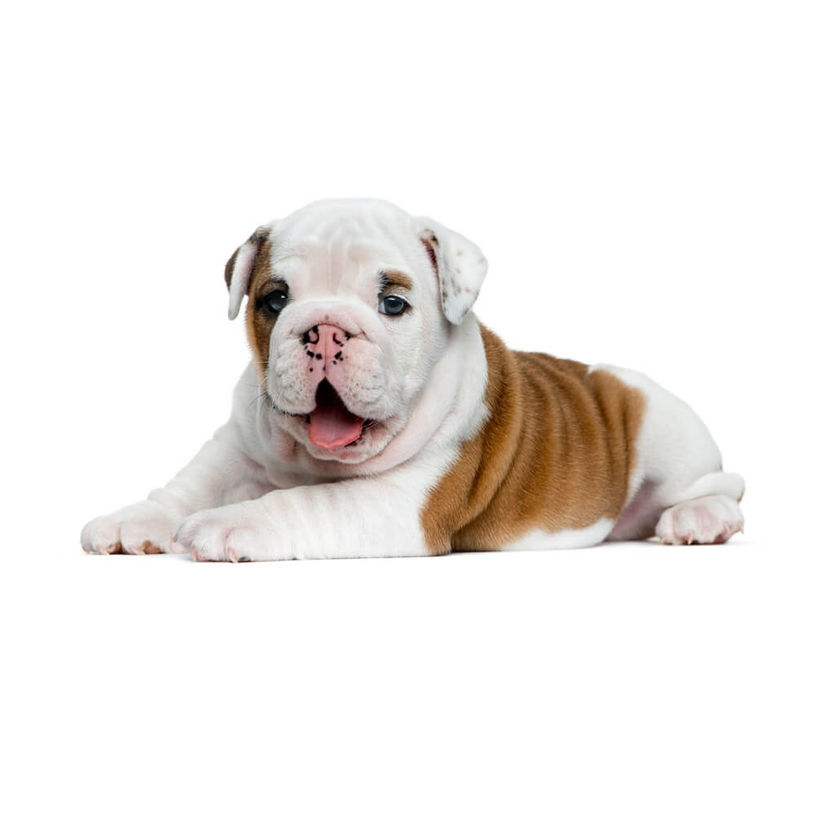Although the English Bulldog's appearance is awe-inspiring, it is one of the most gentle of dogs. They will chase off any intruder and few would risk a confrontation with a dog brave enough to fight a bull. It is described as a very affectionate and dependent animal, gentle with children, but known for its courage and excellent guarding skills.
Determined and stubborn, dogs of this breed can be very persistent and persuasive. They do not give up easily. Bulldogs are people dogs, they seek human companionship and enjoy every minute of it. It takes a lot of human attention to keep this breed happy.
Some English Bulldogs can be dominant and need an owner who understands leadership and pack psychology. A Bulldog that correctly understands its place in the human pack is trustworthy with all people. This breed gets along well with other household pets, but can be wild and unpredictable with strange dogs it does not consider part of its pack. When young, Bulldogs are full of energy, which diminishes as they grow older.
They snore very loudly and most are prone to drooling. Bulldogs that show possessive behaviour, such as guarding furniture, their food, toys or other parts of the house, or aggressive behaviour towards other dogs, usually do not have people around them who are pack leaders. This behaviour can be corrected as long as the owner begins to provide the necessary leadership.
Dogs that are leaders in the home instead of their owners are not as happy as those that have a human leader, as it is very stressful for a dog to have to keep "their" people in line.
The Bulldog is small in stature, but broad and compact, with a thick, massive head. His head should be broad (the broader the better) with the cheeks extending to the sides of the eyes, and the skin of the head and forehead should fall in tight folds. The muzzle is short and flattened, the nose is broad and black with large nostrils; the upper lip should hang down and the lower jaw has a pronounced protrusion. The eyes are very round, set wide apart and very dark. The ears should be small and thin, folded back in a rose shape. The tail is short and carried low on the body.
The coat may be reddish, tan, yellowish brown, parchment, beige, pale red or white, or any combination of these colours. Black is not acceptable. The muzzle is sometimes black. The Bulldog walks deliberately, with stocky legs placed at each corner of his muscular body, and with some sway.
Respiratory problems : Some have very small windpipe. They have poor eyesight and are prone to heatstroke in hot weather, very hot rooms and cars. They are also very sensitive to cold. Females often give birth by caesarean section due to the size of the pups' heads. Their gastrointestinal system is very active and can be offensive to people with sensitive noses! They are also prone to skin problems and hip and knee problems.
ENGLISH BULLDOG
Character
Description
Living Conditions
The English Bulldog is well suited to apartment living. They are very lazy at home and do not need a garden. This is an indoor breed. Bulldogs do well in temperate climates as they get cold easily in the cold and find it difficult to cool off in the heat.
Exercise
Life Expectancy
Some English Bulldogs may not exercise at all, while others are full of energy. Either way, they should be taken for at least one walk a day to satisfy their instinct to run. English Bulldogs that are fit can move very fast for short periods of time.
The average is 8 years. Some dogs live longer, others shorter.
Health Problems
Grooming
History
Their short and soft coat requires very little grooming. Brush regularly with a hard, short brush and bathe only when necessary. The wrinkles on the face should be cleaned daily with a soft cloth. This breed is of moderate pluck.
Today's Bulldogs are very different in character from their ancestors. The breed is descended from the ancient Asian Mastiff, but its development was entirely in Britain. The name Bulldog, which originated in the Middle Ages, refers not only to the appearance of a "little bull", but also to the force with which a small dog would attack bulls in the arena, before the practice was outlawed by law in the 19th century.






